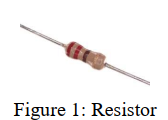Resistor
A resistor (shown in Fig.1) is a block of material that limits the flow of current. The greater the resistance, the lower the current will be. The size of the resistor increases with an increase in power or wattage rating. Resistors either belong to fixed type or variable type group. Fixed Resistors include moulded-carbon composition resistor, carbon-film resistor, and wire wound resistor. Variable resistors are generally known as rheostats and the smaller ones are called as potentiometers (pots) which are usually used in circuits.

Resistor’s Symbol: Resistors have two leads (points of contact) to which the resistor can be connected to an electrical circuit. A symbol for a resistor used in electrical circuit diagrams is shown in the Fig.2. The endpoints at the left and right sides of the symbol indicate the points of contact for the resistor.

Resistance: Resistance is a characteristic of Resistor that indicates the measurement of current opposition. Resistance has a symbol R measured in Ohm (Ω).
Colour Coding: Cylindrical resistors (axial) usually have coloured bands that indicate a number and a multiplier. Resistance bands are next to each other, with a tolerance band slightly farther away from the resistance bands.
Value of a Resistance: The first and second bands represent the first and second significant digits. The third band is the multiplier i.e. the number of zeroes. The fourth band shows the manufacturer’s tolerance. The representation of four band scheme is explained in Fig. 3. The numerical values related with the colour for fixed resistors is shown in Table 2.

Tip: In order to remember the sequence of these colour codes, one can memorize the following sentence wherein the letters in bold depicts the colour: B.B.ROY of Great Britain was a Very Good Worker
Example: What will be the range in which the following resistor’s (Fig. 4) value lie?

Let’s have a look on the colour coding table: The first and second bands as shown in Fig.4 are yellow and violet corresponding to numbers 4 and 7 respectively. The third band orange is the multiplier i.e. 103. The fourth band which is gold shows the tolerance of ± 5%. So, the value of the resistor is 47×103 ± 5% or 47KΩ ± 5% Now, 5% of 47 KΩ = 2.35 KΩ.
Hence, the range of the resistance should be within 47 KΩ ± 2.35 KΩ, i.e. 44.65 KΩ and 44.35 KΩ


